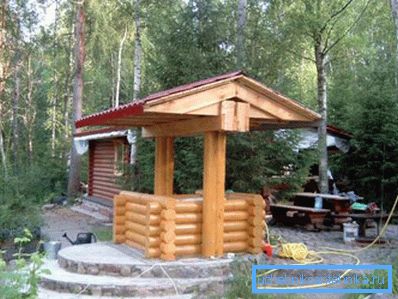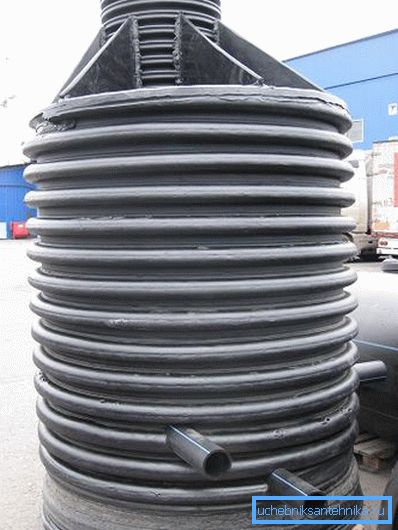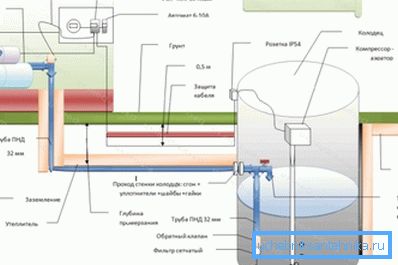Water supply from the well - improving housing conditions
It is much easier to carry out a water supply system from a well with your own hands than it might seem at first glance if you use modern materials and arm yourself with the necessary tools.
Any country house needs its own communications to ensure an adequate level of comfort for residents. No matter how beautiful and spacious it is, but if it doesn’t have the most necessary things: running water, electricity and sewage, there can be no comfort or coziness.

Even if the site is located in the suburbs and there is a centralized city water supply, then, as a rule, it cannot provide adequate water quality and very often there are interruptions in its work due to poor technical condition.
For this reason, many homeowners are starting to equip their own sources of fresh water in the form of a drilled well or a dug well. Both types of sources are equally popular, but digging a well financially is much cheaper than drilling a well, moreover, it makes it possible to decorate a site with a wooden house and a headboard lined with stones.
If you are interested in the version of the device own water supply from the well - watch the video in this article.
Types of wells
Mine shafts can be made of various materials that classify the types of wells.
For mine equipment can be used:
- reinforced concrete rings;
- plastic wells for water supply;
- stone or brick;
- tree.

Wood is practically not used to seal the shaft today, since the price of such an arrangement will be too high. Before laying, this material requires additional processing by various special means that protect the tree from moisture.
Special woodworking and woodworking tools are required. The process of finishing the mine and sealing the seams takes a lot of time and all this translates into a good penny.
To equip a well for a brick water supply is also decided by few, since the volume of work on laying and waterproofing takes a lot of time and also costs a lot.

Reinforced concrete wells are widely used in modern construction, since their cost is many times lower than wooden or brick ones. For their construction are used monolithic reinforced concrete blocks in the form of rings, which are worn over each other, forming a mine.
The seams between the rings are sealed with ordinary cement mortar with the addition of glue. The use of monolithic rings significantly speeds up the installation process, gives the mine greater strength and durability, easy to maintain.
Recently, plastic wells were actively used for water supply, since they represent a monolithic construction of various sizes and have such characteristics as:
- high resistance to high loads due to the elasticity of the material;
- increased wear resistance;
- the presence of a smooth inner surface that prevents the formation of growths;
- possibility of use on all types of soil;
- small proportion of plastic;
- speed of installation.

Plastic is not exposed to alkalis and household chemical compounds, it is for this reason that it is also actively used for the equipment of sewage systems, as well as installing a wet well on the water supply system or drainage system.
Advantages and disadvantages of wells
Like all other types of freshwater sources, the well also has its advantages and disadvantages.
Of the advantages of wells can be noted:
- long service life (from 50 years);
- low cost compared to well drilling;
- ease of maintenance and cleaning due to the large diameter of the mine;
- No special permits are required for the construction of the well.
Among the disadvantages of the source can be noted:
- the complexity of the work when digging mines to a greater depth;
- water quality is significantly lower than in the well due to the insignificant depth;
- there is a high probability of contamination by the upper layer in case of poor-quality construction and sealing.
Wiring diagram
The connection scheme of the water supply system from the well and the equipment used in it may vary depending on the depth of the source and the required pressure in the domestic water supply system. In any case, for the installation of water supply you will need a pumping station, which will take water from the well and direct it under pressure to consumers.
Usually two types of schemes are used:
- station with a deep well pump (at deep wells);
- station with a surface centrifugal pump.
The pumping station is a pumping unit with an electric motor, a storage tank and an installed pressure switch. The pump pumps water into the supply tank filled with air to create the necessary pressure.
The relay controls the level of pressure in the system and, in the event of its falling to the set level, turns on the pump, dials the maximum level, and when it is reached, the pump automatically turns off.
The station can be equipped with a submersible or centrifugal pump. The water supply is connected from a well with a depth of less than 8 meters by a station with a centrifugal pump. A non-return valve is put on the water inlet nozzle, which, when the pump is turned off, prevents water from going back to the well, since centrifugal pumps are not recommended to operate in idle mode.
Also, coarse and fine filters are installed in front of the well pump itself, since the ingress of small particles of sand can damage the unit.

Stations with a submersible pump are used in wells with a depth of more than 8 meters, since the centrifugal unit cannot lift water from such depths on its own. The submersible pump is lowered into the water and also connected to a pressure switch that automatically turns it on and off.

Tip: When choosing a ready-made station, it is important to remember that each of them is accompanied by instructions with all its technical characteristics that should fit your conditions. In each case, the choice of pumping station and methods of connection should be approached with special responsibility or ask for help from specialized companies.
Types of water pipes
Before making a water supply from a well, it is necessary to determine the seasonality of its work.
Depending on the seasonality, water supply is conventionally divided into two types:
- winter (photo);

- summer (photo).

Many people use summer plots only in the warm season for rest or growing food, and for the winter period the cottage is preserved until the next season. In such cases, it makes sense to use the summer version of the plumbing.
In this embodiment, the entire pipe system is manufactured in a collapsible form and laid across the site directly over the ground or temporarily dug in to a depth of 20-30 cm. At the end of the season, the system is disassembled and stored in a technical room until next summer.
Conclusion
If you live in a private house all year round, you should consider a winter option: how to make a water supply system from a well, since it is an order of magnitude more difficult than the summer one and requires additional insulation of pipes or laying of pipelines below the ground freezing level.
Insulation will require additional financial costs, and digging trenches for pipes to a depth of more than one meter to prevent freezing will take a lot of time and effort. Here you decide which option suits you best.